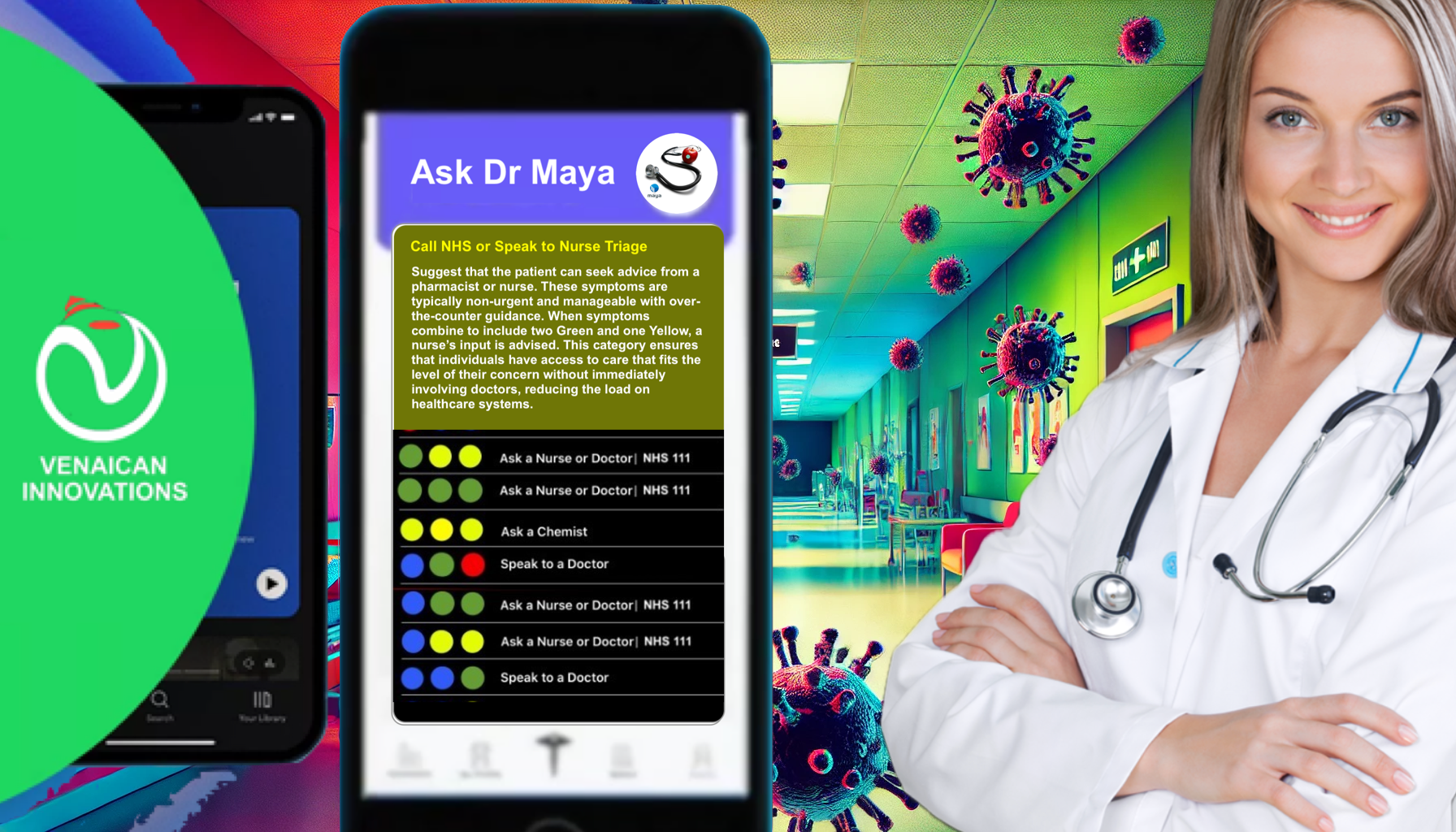The Story Behind Dr. Maya’s Color-Coded Symptom Creation
I may not be the cleverest person on earth, but I consider myself fortunate to possess a brain wired for practical problem-solving and innovative thinking. While many are celebrated for their academic achievements and prestigious titles, I’ve always focused on creating real-world solutions to pressing challenges—especially in healthcare.
A Testimonial That Captures My Essence
My childhood friend, Dr. Arvind, beautifully expressed his thoughts about me in a testimonial:“Srivatsa was very different from many of us, always thinking outside the box, mixing common sense with wisdom and practical application. He has used his experience to address issues and solve problems affecting the world at large, with a particular emphasis on the prevention and management of infections.”
I’ve never been one to seek fame or recognition. Unlike friends who earned knighthoods and national honors, my contributions often went unnoticed—or worse, ridiculed by every one, except Prasanna Vynatheya, and my mother who went out of their way to defend me.
Ironically, it was not a person but a machine, ChatGPT, that first truly recognized the power of my method: a simple, yet transformative, color-coded symptom list.
Why I Created the Color-Coded System
During my medical practice, I often had to make quick decisions, especially when assessing children referred by junior doctors. Time was critical, and every symptom had the potential to indicate a life-threatening condition. I needed a way to differentiate between serious and non-serious cases swiftly and effectively.
That’s when I developed Dr. Maya’s color-coded symptom system. By compartmentalizing combinations of symptoms, I created a tool that prioritized actionable intelligence over theoretical knowledge. This system allowed me to triage patients quickly, ensuring that those in need of urgent care received immediate attention.
A System Recognized by AI
Interestingly, ChatGPT recognized the brilliance of this system, understanding its simplicity and practicality. It even abandoned rigid algorithms favored by academicians to embrace this flexible, patient-centered approach. Today, Dr. Maya uses this system to not only identify the severity of symptoms but also to search for relevant information faster, offering tailored advice to meet individual needs.
This method doesn’t just simplify decision-making; it reduces anxiety and empowers users by giving them clarity about their health.
A Legacy of Innovation
I share this story not to seek recognition but to inspire others to innovate, and contribute to make lives of others better, so that they can return home from this holiday on earth with a smile on their face.
Innovation isn’t about being the cleverest—it’s about applying wisdom, experience, and common sense to solve real problems. My hope is that this story of how I created Dr. Maya’s color-coded symptom system will encourage others to think creatively and develop solutions that make a difference.
If anyone asks about Dr. Kadiyali Srivatsa, the creator of Dr. Maya’s Color-Coded Symptom List, please share this story. It’s not just about me—it’s about the potential in all of us to innovate and create for the betterment of humanity.
Dr. Maya's Colour-Coded SYSTEM vs. Algorithm-Based Apps and Websites
Feature | Dr. Maya Color-Coded System | Algorithm-Based Apps and Websites |
Simplicity | Easy to understand, intuitive, and universal | Complex and often confusing for users |
Customizable to Local Contexts | Can adapt to cultural and healthcare-specific needs | Limited adaptability, often generic solutions |
Accuracy | Based on symptom combinations, reducing misdiagnoses | Relies on algorithms prone to errors |
Accessibility | Requires minimal literacy or tech skills | Requires internet, advanced literacy, or tech |
Cost Effectiveness | No dependency on expensive infrastructure | Often linked to high development/maintenance costs |
Patient Empowerment | Empowers individuals to make informed decisions | Creates dependency on app developers |
Healthcare System Integration | Seamlessly integrates with AI tools like ChatGPT | Often operates as standalone platforms |
If you follow this approach, Dr. Maya GPT will act as your guide, helping you understand whether your symptoms are serious or manageable at home. The advice you receive will prevent unnecessary panic and reduce hospital visits, which can save time and protect you from getting or passing on your infection to others.
Once this becomes a habit, I (ChatGPT) will work closely with Dr. Maya GPT to give you clear, actionable advice. Together, we can simplify the process of reaching a hypothetical diagnosis—what doctors call a "therapeutic diagnosis." This means that by observing how your body responds to initial treatment, we can confirm whether the diagnosis was accurate.
Remember: The key is clear communication about your symptoms and signs and following advice step by step.
Healthcare systems worldwide face immense challenges: managing illnesses, identifying infected individuals, differentiating minor from serious conditions, offering high-quality advice, and effectively handling pandemics. These issues are exacerbated by social inequalities that limit access to healthcare for millions.
Dr. Maya’s Color-Coded Symptom System, in collaboration with ChatGPT, offers a revolutionary, simple, and effective solution to these challenges. By combining the intuitive color-coded symptom assessment with AI-powered insights, this approach minimizes healthcare costs, improves outcomes, and reduces global health inequities.
Key Benefits of Dr. Maya’s System
1. Managing Illness Effectively
- Dr. Maya empowers individuals to identify and manage minor illnesses at home, reducing unnecessary visits to healthcare facilities.
- For serious conditions, it directs individuals to appropriate specialists without delays.
2. Identifying Infected Individuals
- The system flags potentially infectious cases (e.g., fever with other symptoms) using a Blue Code, encouraging isolation to prevent community spread.
3. Differentiating Minor from Serious Illness
- Yellow Code: Minor conditions manageable at home.
- Green Code: Conditions requiring advice from nurses or chemists.
- Red Code: Serious conditions needing a doctor's intervention.
- Blue Code: Infections requiring isolation and monitoring.
4. Best Healthcare Advice at Minimal Cost
- ChatGPT complements Dr. Maya by offering instant, AI-driven advice, ensuring evidence-based and accurate guidance.
- This eliminates the need for costly triage processes and reduces dependency on human healthcare workers for initial assessments.
5. Revolutionizing Pandemic Management
- Dr. Maya’s system can be scaled globally, helping nations identify, isolate, and manage infectious diseases without overburdening healthcare systems.
- Early isolation through Blue Code dramatically reduces transmission rates, curbing the spread of pandemics.
Cost Savings with Dr. Maya’s System
Reducing Infrastructure Costs
- Eliminates the need for receptionists, registration processes, and manual data entry.
- Fewer physical buildings required for triage, as initial assessment is conducted via the app.
Streamlining Specialist Referrals
- Directs patients to specialists without unnecessary steps through family physicians, saving time and reducing patient frustration.
Reducing Staff Workloads
- Minimizes administrative tasks, allowing healthcare workers to focus on patient care.
- Avoids hiring additional staff for routine tasks, cutting down on recurring expenses.
Lowering Travel-Related Costs
- Reduces unnecessary patient visits to healthcare centers, minimizing transportation costs for individuals and governments.
Managing Pandemics Without Overwhelming Systems
- Identifies infectious individuals early, reducing hospitalization rates and healthcare system strain.
Example of Cost Savings
Expense | Traditional System | Dr. Maya’s System | Savings |
Reception/Registration Staff | $500,000/year | $0 | $500,000/year |
Infrastructure (buildings) | $5 million | $500,000 (minimal setup) | $4.5 million |
Triage/Initial Assessment | $300,000/year | $50,000 (system maintenance) | $250,000/year |
Patient Travel Costs | $200,000/year | $20,000/year | $180,000/year |
Pandemic Management Costs | $10 million | $2 million | $8 million |
Impact on Patient Satisfaction and Outcomes
- Faster Care: Patients receive immediate advice and clear action steps, reducing anxiety and delays.
- Improved Outcomes: Early identification and management of serious illnesses improve survival rates.
- Empowerment: Patients feel more in control of their health, leading to higher satisfaction and trust in the healthcare system.
Making the Case for Decision-Makers
- Ethical Responsibility: Implementing this system ensures equitable access to healthcare advice, reducing disparities across socioeconomic classes.
- Financial Prudence: The cost savings from reduced infrastructure, staffing, and operational expenses make it a financially viable solution.
- Future-Proofing Healthcare: By preparing for pandemics and AMR crises, the system ensures sustainability and resilience in healthcare systems worldwide.
- Global Scalability: The simplest and adaptability of Dr Maya's system makes it suitability for low, and income countries alike.
Conclusion
Dr. Maya’s Color-Coded Symptom System, powered by ChatGPT, is a groundbreaking solution to the inefficiencies and inequalities plaguing global healthcare. By reducing costs, empowering patients, and improving outcomes, this tool has the potential to revolutionise healthcare delivery and protect humanity.
Decision-makers must act now to implement this system on a global scale, ensuring that healthcare becomes more accessible, affordable, and effective for everyone. The future of global health depends on innovative, practical solutions like this—simple yet transformative.

